Although the foundations of the Ecuadorian diet are rice and potatoes and would appeal to even the pickiest of eaters, there is much to discover beyond the basics.
For foodies who claim to eat anything – just go with it. You will be rewarded handsomely by the delectable range of food in Ecuador to choose from.
But, for the tamer eater, eating adventurously in Ecuador may require stepping outside of your food comfort zone. Pushing yourself to try even one new bite may result in a great discovery. Take a cue from Sam-I-am on this one, and just try it.
One tactic that works pretty well is to simply not ask what you are eating until after you’ve tasted it. Then, once you find out you’ve just eaten intestine or squid ink, you’ll be cool with it because it was dee-licious.
The Food in Ecuador You Should Definitely Eat
There are many, so although not exhaustive, here’s my list of the foods you should get over yourself and try when in the tiny, equatorial country.
Cuy and Other Critters
Those little guinea pig, or cuy, are so darn adorable, with their fluffy fur and big eyes, but don’t let their cuteness convince you that they won’t taste good.
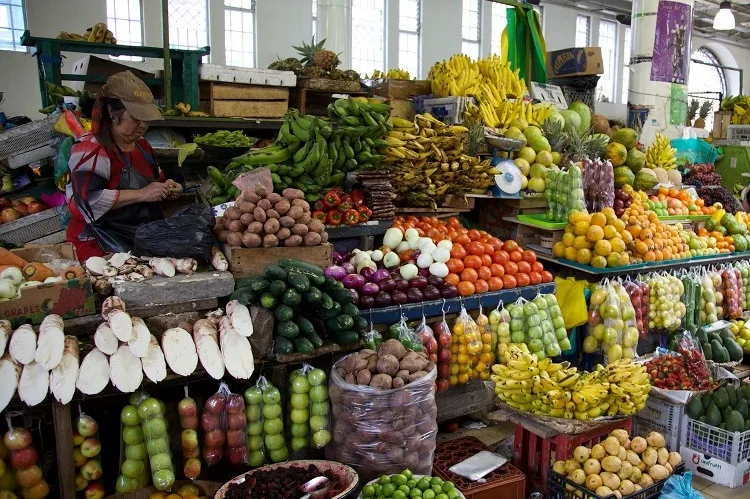
Because they do, and it’s not any different than eating any other animal that you eat on a regular basis. Just because they’re cute doesn’t mean you shouldn’t eat them.
Now, do be aware that the appropriate way to eat the cuy is to suck the brain out of the skull.
It is considered a delicacy, so just do it, smile, and be nice about it. If you just can’t quite get visions of your childhood pet out of your mind, don’t fret. There are plenty of other carnes to enjoy.
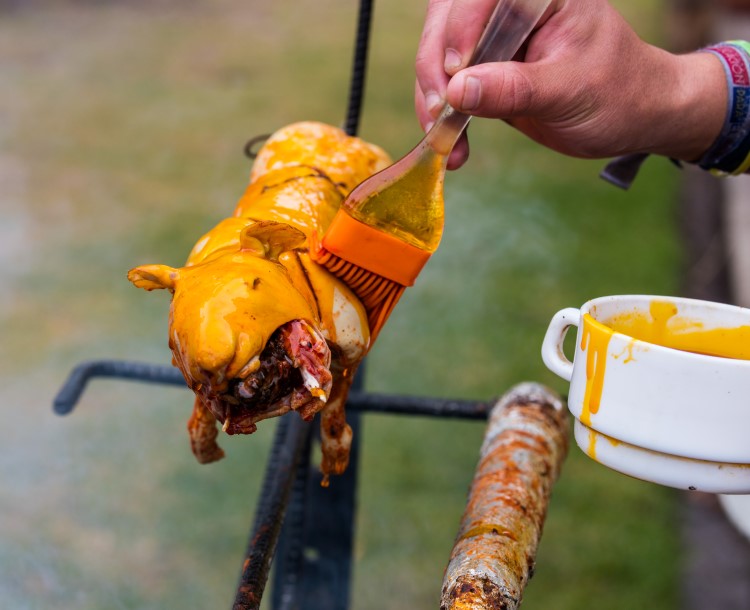
Ecuador’s cuisine varies along with the elevation. In the mountains of the highland, you’ll find a wide variety of hearty meats and heartening soups and stews.
That’s because it’s cold up there. You’ll find hornado (whole roasted pig) in markets in the highland and which are best eaten with potato cakes called llapingachos and ripe avocado.
Another yummy meal for a cold day is seco de chivo (goat stew) served in a nice big bowl with ripe avocado and sweet plantains.
Guatita (a peanut-y tripe stew) is a meal that leaves an impression. Although it may not sound appealing, the nutty flavor melds perfectly with the chewy tripe.
Friends of the Sea
Along the coast where hot weather prevails, the cuisine centers around seafood, especially shrimp. Ecuador is a major exporter of shrimp, but there’s nothing better than getting it fresh off the boat.
Shrimp ceviche is a must. Really, ceviche of any kind is worth a try. Traditionally, fish or shrimp is “cooked” by lime juice, but nowadays the shrimp is typically cooked first and drenched in a limy, tomatoey sauce.
The secret ingredient, interestingly, is ketchup – but don’t judge. Somehow it works. Ceviche is topped with crunchy fried plantains and popcorn.
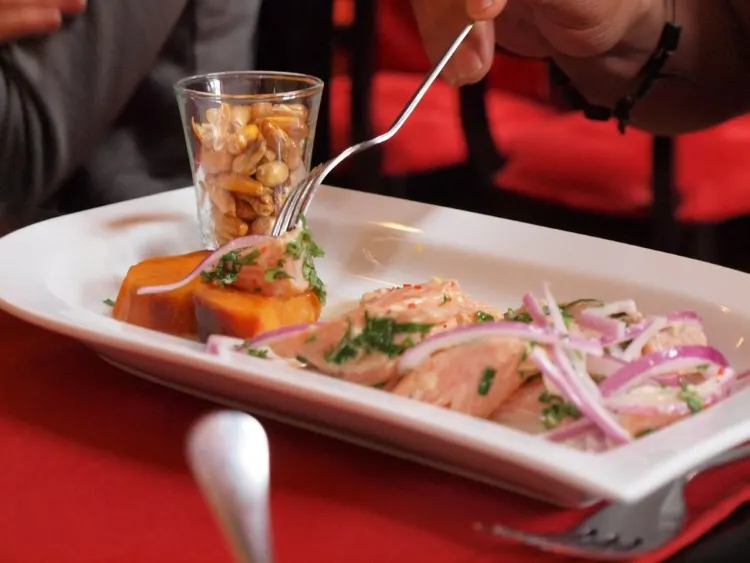
Once you’re decidedly convinced by the fish and shrimp ceviche, give the squid a try.
Ink included, the black color of the dish is not something you see too often, but the subtle, almost vinegary taste will delightfully linger.
And if you should find yourself in the state of Manabí, hunt down a joint where you can give the fish with peanut sauce a whirl.
Fantastic Fruit
Situated on the equator, hence the name Ecuador, the country is ripe with lovely varieties of fruits; also meaning that there are neverending varieties of fruit juices, or jugos.
Fruit mixed with milk is another yummy beverage known as batidos. A creamy batido served with a little empanada is the perfect pick-me-up to get you through the afternoon, or anytime of the day, in fact.
Some favorites for juices and batidos include mora (Blackberry), maracuya (Passion fruit), and sandia (Watermelon). Guanábana, translates as soursop, but I had never heard of this fruit before living in Ecuador.
It’s a smooth white fruit that tastes almost custardy, and it’s a popular yogurt flavor, too. Tomate de árbol, or tree tomato, is another fruit unique to the region. It’s a sweeter, tangier version of a tomato. Cue mouth-watering.
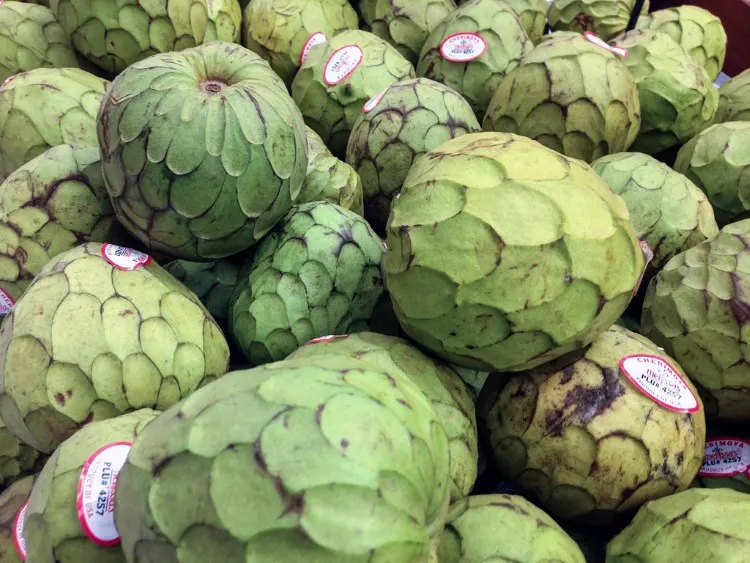
There are other fruits that make frequent appearances, but not in juices necessarily. Cherimoya is a small fruit with green exterior and white, creamy interior (similar to guanábana). I
also have a soft spot for the uvilla, a tiny orange grape-sized fruit that is reminiscent of a tomato, but sweeter, and is sometimes referred to as a gooseberry.
Sidenote: I’ve also seen these unassuming fruits in U.S. farmer’s markets branded as the Peruvian superfood called the pichuberry. I’m not sure they possess any super qualities, although, they taste pretty super, and are probably good for you, too.
And bananas. Oh, the bananas. They come in all sizes and with distinct flavors. A particularly special one called oritos (little golds) will put to shame any banana you’ve previously eaten.
This snack is bursting with sweet banana flavor. I dare you to eat just one.
Where to Find the Best Ecuadorian Cuisine
In Quito, I lived just down the street from a giant supermarket that I thought would be perfect for all of my grocery needs.
I quickly discovered that supermarkets are not the best place to shop or eat in Ecuador because they a) are expensive and b) don’t feature the best local foods.
Instead, follow these tips to maximize your eating experience.
Markets
The place to go to do your actual shopping is the local market. Every neighborhood likely has a small one and every city or town will also have at least one large, central market as well.
Beyond food, markets also sell everything from clothes, to kitchen supplies, cleaning products, spices, electronics, and so on.
I’m still grateful for my Spanish teacher for taking me to the Quiteño market during a class session one day. So, my best advice is to ask a local friend to accompany you to the market.
You can learn a lot by observing, listening, and asking questions from a pro. In doing so, you will see that haggling is expected, learning a few key phrases in Spanish is essential, and your senses will be on overload.
If you don’t feel like cooking, don’t worry. You have some great options to grab a great lunch or snack.
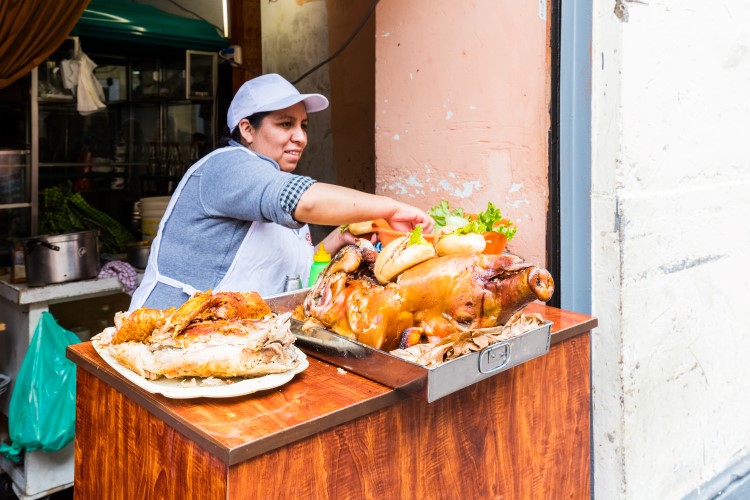
Almuerzos
Ecuadorians know how to do lunch. Being the main meal of the day, it’s typical to find a full, three-course meal, complete with soup, an entree with meat, potato and veggies, and a lovely fresh juice; all for less than two dollars.
Almost every restaurant has their own version of the almuerzo, or lunch. Sometimes you get a choice, and sometimes you don’t, but either way, you will leave full.
Higher-end restaurants may charge up to six dollars for an almuerzo. Sometimes that means you’re getting higher quality food, but not always.
The rule that you get what you pay for doesn’t necessarily stand here, since restaurants in tourist areas may charge more just because they can.
Look for restaurants that are fairly busy with local patrons, or ask for a recommendation. Then, you can go frequently to your favorites because the menu is sure to change almost daily.
Street Food
The same rule applies to street food in Ecuador as applies to restaurants. Look for busy stalls and ask for recommendations from locals. In Quito, I frequented one stall almost weekly in Parque El Ejido.
They served the best ceviche de chochos (lupini beans) ever. I can still taste it, and at one dollar, it was the best deal in town.
When friends or family would visit, typically I’d wait a few days before suggesting street food, just to give their stomach a chance to acclimate.
Another tip I picked up if you know you might be eating some new or unfamiliar fare is to chew a couple of Pepto Bismol tablets in advance of the meal. I did that on a few occasions, and it certainly didn’t hurt.
Other foods prime for eating on the street include empanadas, especially empanadas de viento, which are sort of like airy doughnuts, and chifles and patacones, two different varieties of fried plantains.
And, if you are not headed to Ecuador anytime soon (sad face), there is one lesson to be applied no matter where in the world you are: don’t be afraid to eat.
The moral of the story is that there’s really nothing to be scared of. It won’t bite you. In fact, you’re biting the food.
So, take that, food!
This is a guest post from my blogging buddy Jannan from Wander on Purpose with advice about the most delicious food in Ecuador. Read about how you can travel, across the street or across the world, on her blog.
Jannan Poppen is an educator turned writer, travel enabler, yoga enthusiast, and Giving Coordinator for See Beautiful. Through writing she encourages travel and empowers others to push themselves beyond their perceived limits.
She ultimately seeks to help others (and herself) recognize their true capabilities and self-confidence through travel. Jannan spends her days writing, doing yoga, hiking, gardening, traveling near and far (mostly near), spending time with her family, and consuming fairly large amounts of tea and coffee.
Find her latest travel stories and advice at jannanpoppen.com, or connect through Instagram, Facebook, or LinkedIn.

William
Thursday 1st of September 2016
Thanks for an enlightening review of some of the top foods of Ecuador. I agree, based on my limited experience in Quito and surrounding towns that the markets are the best for finding local foods.
Steph Dyson
Tuesday 13th of September 2016
Hi William, I'm glad you found the piece useful! I think markets are always a great idea - although you sometimes have to get over how weird things look! But sometimes with food, the stranger the better, right?